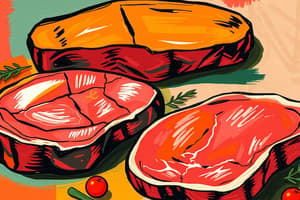Podcast
Questions and Answers
What is the primary function of water in the body?
What is the primary function of water in the body?
- Regulation of body temperature
- Digestion of feeds
- Transport of nutrients and waste (correct)
- Maintenance of body shape
What type of forages are tall fescue and bluegrass?
What type of forages are tall fescue and bluegrass?
- Summer annuals
- Cool-season perennials (correct)
- Warm-season perennials
- Winter annuals
What is the primary characteristic of a ruminant?
What is the primary characteristic of a ruminant?
- Small intestine
- Large intestine
- Single-chambered stomach
- Four-chambered stomach (correct)
What is the approximate percentage of the body composed of water?
What is the approximate percentage of the body composed of water?
What type of forages are Bermudagrass and Switchgrass?
What type of forages are Bermudagrass and Switchgrass?
Which of the following is NOT a legume?
Which of the following is NOT a legume?
What is the name of the largest compartment in the ruminant stomach?
What is the name of the largest compartment in the ruminant stomach?
What is the function of the omasum in the ruminant stomach?
What is the function of the omasum in the ruminant stomach?
What is the name of the second compartment in the ruminant stomach?
What is the name of the second compartment in the ruminant stomach?
What type of forages are pearl millet and tifleaf millet?
What type of forages are pearl millet and tifleaf millet?
Flashcards are hidden until you start studying
Study Notes
Beef Quality Grades
- Found in fine restaurants and gourmet stores
- Beef quality grades are determined by the amount of marbling and carcass conformation
- Prime grade has the most marbling and is not economical for the meat packer
- Choice grade is the most economical and desirable carcass grade
- Select grade has slight marbling and is not marked with a USDA stamp
- Standard grade has minimum marbling or below average carcass conformation
- Commercial grade is usually processed into lunch meats, soup, and canned meat products
- Cull grade is not acceptable for human consumption
Yield Grades
- Identify carcasses for differences in cutability (lean yield of a beef carcass)
- Yield grade is determined by hot carcass weight, external fat, percent heart, kidney, and pelvic fat, and rib eye area
- Types of yield grades:
- Moderately Abundant
- Slightly Abundant
- Moderate
- Small
- Slight
- Yield grade 1 is the leanest, heaviest muscled carcass, and yield grade 5 is the lightest muscled, fattest
Dressing Percentage
- The percentage yield of chilled carcass in relation to the weight of the live animal
- Dressing percentage depends on the quality grade of the animal
- Example: a 1000 lb prime steer would produce a 620 lb carcass
Health
- Temperature: 100-102.5 degrees Fahrenheit (calves: 101-103)
- Heart rate: 60-70 beats per minute
- Respiratory rate: 8-16 breaths per minute
Nutrition
- Six basic nutrients: protein, carbohydrates, lipids, minerals, vitamins, and water
- Protein: provides essential amino acids, essential for growth and repair, forms part of muscles, internal organs, skin, hair, wool, feathers, hoofs, and horns
- Carbohydrates: used as energy, represent the largest part of an animal's feed supply, fibrous part of the diet, include sugars, starch, and cellulose
- Fats: concentrated source of energy, form cholesterol, steroids, and other body compounds, found in every cell, composed of carbon, oxygen, and hydrogen
- Minerals: needed in nearly all parts of the body, primarily found in bones and teeth, divided into macro and micro minerals
- Vitamins: required for health, development, and metabolic reactions, needed in small amounts, divided into fat-soluble and water-soluble vitamins
- Water: most important nutrient, accounts for 70% or more of the composition of most plants and animals, controls body temperature, enables living plants and animals to hold their shape, involved in transport of nutrients and waste, helps in digestion of feeds
Common Forages for Beef Cows
- Cool-season perennials: most growth occurs in spring and fall, include tall fescue, bluegrass, orchard grass, perennial ryegrass, clover, alfalfa, birdsfoot trefoil, and lespedeza
- Warm-season perennials: most growth occurs in summer, include bermudagrass, switchgrass, and flaccidgrass
- Winter annuals: must be planted each year, most growth occurs in early spring and late fall, include annual ryegrass, cereal grains, arrowleaf clover, and crimson clover
- Summer annuals: must be planted each year, most growth occurs in late spring and summer, include pearl millet, tifleaf millet, and sorghums
Digestive System
- Ruminant Defined: an animal with four distinct compartments in its stomach, which swallows its food essentially unchewed, regurgitates it, chews it thoroughly, and reswallows it
- Four Compartments of the Ruminant:
- Reticulum (honeycomb)
- Rumen (paunch)
- Omasum (manyplies)
- Abomasum (true stomach)
Studying That Suits You
Use AI to generate personalized quizzes and flashcards to suit your learning preferences.




